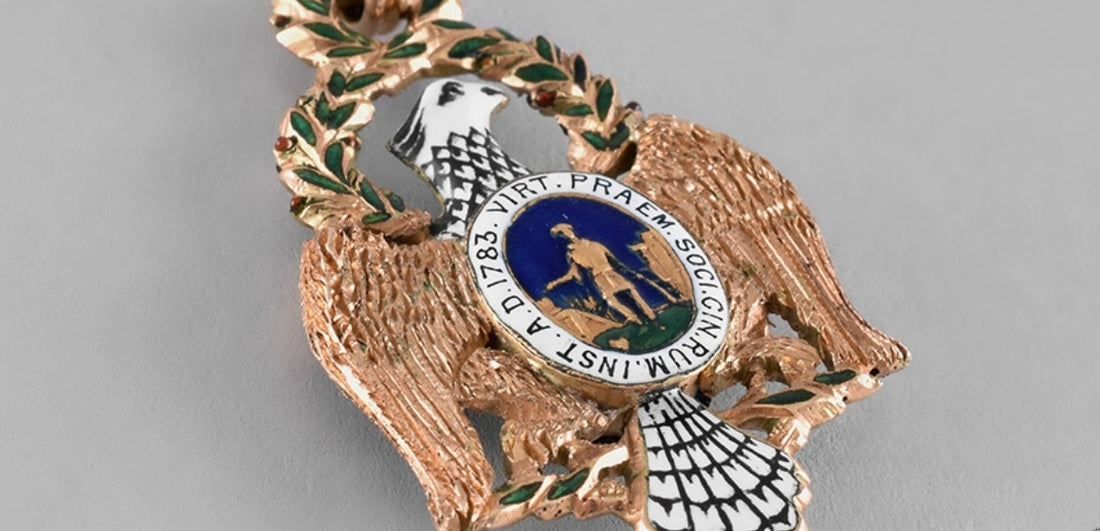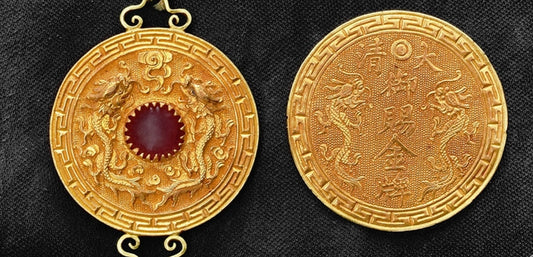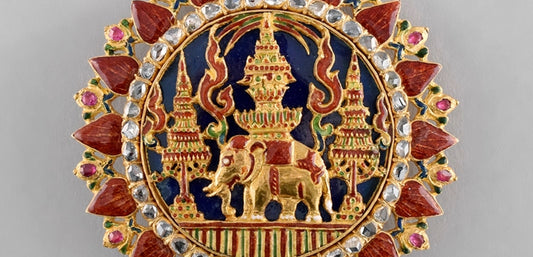The oldest hereditary society in the United States, the Order of the Cincinnati Eagle is widely sought after due to its early historical significance and American legacy. Sold for $32,000 USD in November of 2018, the “Knox Eagle” c.1810, was brokered on behalf of the Goodwin Estate and stood as a very early American manufactured version, desired by collectors and the order itself.
United States. The Society of the Cincinnati Eagle Medal. The Knox Eagle. (1795-1820). A finely manufactured left facing 14kt Gold Eagle featuring delicately tooled outstretched wings and white enamelled body with hand painted decor, the angular head features a beak, eye and representational feathers, the neck is decorated in cross hatching with the resulting diamond shapes alternating between entirely black and with one dot stemming from the peak into the center of the shape, the tail presents a web design distinguishing individual feathers, beneath the feet and on each side of the tail features a thin green enamelled laurel branch with two leaves on each side, the whole head is surrounded by a green and red enamelled wreath connecting with the base of the neck and shoulder of each wing, surmounted by a smaller integral wreath suspension loop, and loose French double loop ring, obverse centre presents a deep blue medallion with golden figures illustrating two senators presenting a sword to Cincinnatus standing on a green enamelled base, in a white surround the hand painted motto OMNIA RELINQUIT SERVARE REMPB (He abandoned everything to serve his country) beginning at 12 o’clock, centre reverse medallion also in deep blue and green enamel with the Gold figure of Cincinnatus standing alone amongst a house and plow, in a white surround with the hand painted motto VIRT. PRAEM. SOCI. CIN. RUM. INST. A.D. 1783 (Reward of virtue, society of the cincinnati, instituted 1783) beginning just past 12 o’clock, measures 24.2mm (w) x 39.7mm (h - inclusive of integral wreath suspension), 12.3 grams, two small flakes to white enamel on obverse neck, one centrally located above hatching and the other along right side near base of neck where the wreath connects, small chip on obverse right side of tail along edge where the tail meets the perch of the branch, both medallions have been re-affixed, likely by Dr. Goodwin himself.
The American Revolution began in 1776 and persisted until 1873 despite the decisive victory over the English at Yorktown in 1781. The constant presence Americans and French Armies eventually resulted in the English signing of a peace treaty in September 1783.
Major General Henry Knox, General Washington’s Chief of Artillery, had the idea of creating a society long before the resolution of the war. However, it was only on April 15, 1783 that his notions for a fraternal patriotic organization were turned into a written proposal. The Society of the Cincinnati was established roughly one month later, with General George Washington serving as the first President General, until his death in 1799. Military personnel (those who served minimum three years or were dismissed) along with all continental officers were eligible to become members. Approximately 2400 officers joined the Society as original members and made a contribution of one months pay towards the organization and the officer’s families. The principles of the order were as follows: “1. An incessant attention to preserve inviolate those exalted rights and liberties of human nature. 2. An unalterable determination to promote and cherish between the respective states the national honor. 3. To render permanent and cordial affection subsisting among the officers, to dictate brotherly kindness in all things and particularly extend to the most substantial acts of beneficence towards those officers and their families who unfortunately may be under the necessity of receiving it.”
The Insignia of the Society was designed by Major Pierre L’Enfant of the Continental Corps of Engineers. He decided that the medal should be no larger than a dollar, and should contain an eagle, as the bird is specific to the North American continent. The medal, generally known as the Eagle, was partially modelled after the French Order of Saint Louis and the Order of Military Merit. In October of 1783, L’Enfant was commissioned by the President General to sail to Paris and oversee the fabrication of the badges in 1784 by Duval and Francastel. The first group of forty-five were “made in a slight way” (measuring 31mm) costing $17 dollars each. For the other members, L’Enfant had a batch of 140 badges made to be sold to individual societies members, which were sold at $26 each. The Medals have since been manufactured by various American and French firms including Jeremiah Andrews, Tiffany & Co., Arthus Bertrand, and Bailey, Banks & Biddle. The latter was the official insignia maker in the 1960s. The Eagles were largely made by hand, resulting in as many as twenty varieties and patterns. However, they all contain allusions to the Patron Saint of the Roman Dictator Cincinnatus. In a translation of Livy’s History of Rome, it is told that Lucius Quintius Cincinnatus, a citizen and farmer, was appointed Dictator when tidings from five horsemen threatened the city. He accepted the position and under his leadership all potential dangers were driven away. Cincinnatus then resigned from his position and returned to his fields and agrarian lifestyle. For these actions he is revered as the quintessential example of Roman simplicity and patriotism, and the Society aims to follow this precedent in all endeavours.
Criticism of the Society exists in the mid 1780s, when citizens argued that this society of officers, adorned by badges, were claiming they had a duty to protect the liberties that the people fought and gave lives for. The strife became so rampant the Society was nearly abolished, however that action would have insulted the French, who were allowed to wear the badge and considered it an official decoration from the United States. The society forged on, however membership numbers dropped to nearly 300 by the middle of the 19th century resulting in the dissolution of several state societies. By 1854, the rules of membership were altered, allowing the descendents of officers to join, regardless if the officer himself was an original member. This resulted in a flourish of members and an increase in interest. Although the Civil War delayed the vision to revive all societies, it offered a renewed sense of patriotism and encouraged the growth of the organization in both individual numbers and the re-establishment of previously lost societies.
As of 1938, the international headquarters is located at the Anderson House in Washington, D.C. Now in its’ third century, the Society promotes the public interest in the revolution through its library and museum collections, publications and other activities. The Eagle remains a rare and unique representation of the oldest hereditary society in the United States.




